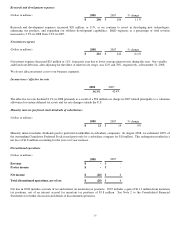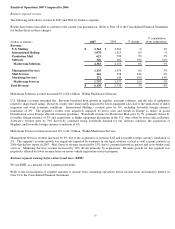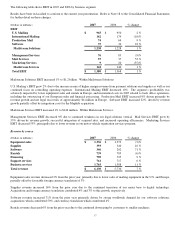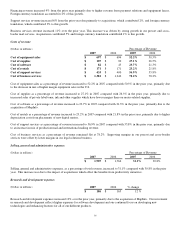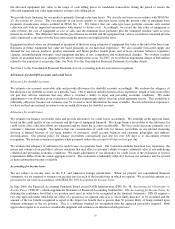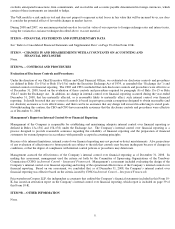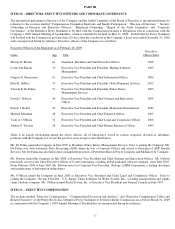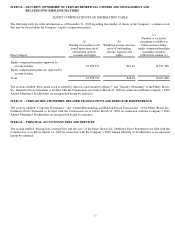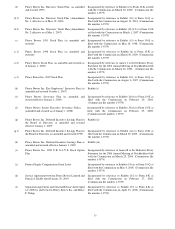Pitney Bowes 2008 Annual Report Download - page 44
Download and view the complete annual report
Please find page 44 of the 2008 Pitney Bowes annual report below. You can navigate through the pages in the report by either clicking on the pages listed below, or by using the keyword search tool below to find specific information within the annual report. 25
We regularly assess the likelihood of tax adjustments in each of the tax jurisdictions in which we operate and account for the related
financial statement implications. We have established tax reserves which we believe to be appropriate given the possibility of tax
adjustments. Determining the appropriate level of tax reserves requires us to exercise judgment regarding the uncertain application of
tax law. We adjust the amount of reserves when information becomes available or when an event occurs indicating a change in the
reserve is appropriate. Future changes in tax reserve requirements could have a material impact on our results of operations.
Based on our 2008 income from continuing operations before income taxes and minority interest, a 1% change in our effective tax rate
would impact income from continuing operations by approximately $7 million.
Long-lived assets
Useful lives of long-lived assets
We depreciate property, plant and equipment and rental property and equipment principally using the straight-line method over
estimated useful lives: machinery and equipment principally 3 to 15 years and buildings up to 50 years. We depreciate other
depreciable assets using either the straight-line method or accelerated methods. We amortize properties leased under capital leases on
a straight-line basis over the primary lease terms. We amortize capitalized costs related to internally developed software using the
straight-line method over the estimated useful life, which is principally 3 to 10 years. Intangible assets with finite lives are amortized
over their estimated useful lives, which are principally 4 to 15 years. Our estimates of useful lives could be affected by changes in
regulatory provisions, technology or business plans.
Impairment review
We evaluate the recoverability of our long-lived assets, including goodwill and intangible assets, on an annual basis or as
circumstances warrant. Our goodwill impairment review requires judgment, including the identification of reporting units, assigning
assets and liabilities to reporting units, assigning goodwill to reporting units and determining the fair value of each reporting unit.
Significant judgments required to estimate the fair value of reporting units include estimating future cash flows, determining
appropriate discount rates and other assumptions. We use internal discounted cash flow estimates, quoted market prices when
available and appraisals as appropriate to determine fair value. We derive the cash flow estimates from our historical experience and
our future long-term business plans and apply an appropriate discount rate. When available and as appropriate, we use comparative
market multiples to corroborate discounted cash flow results. Changes in these estimates and assumptions could materially affect the
determination of fair value and/or goodwill impairment for each reporting unit.
See Note 14 to the Consolidated Financial Statements for further details on our transition initiatives and asset impairments recorded in
2008. We believe that we have no unrecorded asset impairments at December 31, 2008. However, future events and circumstances,
some of which are described below, may result in an impairment charge:
• Changes in postal regulations governing the types of meters allowable for use.
• New technological developments that provide significantly enhanced benefits over current technology.
• Significant ongoing negative economic or industry trends.
• Changes in our business strategy that alters the expected usage of the related assets.
• Future economic results that are below our expectations used in the current assessments.
Pension benefits
Assumptions and estimates
The valuation and calculation of our net pension expense, assets and obligations are dependent on various assumptions and estimates.
We make assumptions relating to discount rate, rate of compensation increase, expected return on plan assets and other factors. These
assumptions are evaluated and updated annually and are described in further detail in Note 13 to the Consolidated Financial
Statements. The following assumptions relate to our U.S. qualified pension plan, which is our largest plan. We determine our
discount rate for the U.S. retirement benefit plan by using a model that discounts each year’s estimated benefit payments by an
applicable spot rate. These spot rates are derived from a yield curve created from a large number of high quality corporate bonds.
Accordingly, our discount rate assumption was 6.05% at December 31, 2008 and 6.15% at December 31, 2007. The rate of
compensation increase assumption reflects our actual experience and best estimate of future increases. Our estimate of the rate of
compensation increase was 4.25% at December 31, 2008 and 4.5% at December 31, 2007. Our expected return on plan assets is
determined based on historical portfolio results, the plan’s asset mix and future expectations of market rates of return on the types of
assets in the plan. Our expected return on plan assets assumption was 8.0% in 2008 and 8.5% at December 31, 2007.


